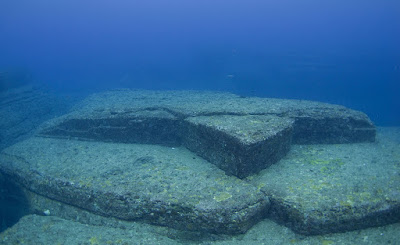Located off the coast of Japan’s Ryuku Islands (off the tip of Yonaguni Island), this stone structure of epic proportions has baffled geologists and archaeologists alike. While some are convinced that the structure is an ancient man-made pyramid, others believe it is a natural geological formation. Of course, there are also others that believe it is a combination of both.
Anyway, here are a few interesting facts that we know about Yonaguni Monument. After which, you can decide for yourself.
Too long to read? Watch the video here.
The Discovery of Yonaguni Monument (Japan’s Underwater Pyramid)
The Yonaguni Monument was first discovered in 1986 by a group of SCUBA divers looking to observe hammerhead sharks. Instead, they came across something far more exciting and mysterious: A huge underwater structure at a depth of just 26 meters below the surface.
 |
| (Image Source: World Adventure Divers) |
Although the structure is not very far underwater, it’s no mystery why the underwater pyramid was not discovered earlier. The monument’s location is known for frequent strong currents as well as poor visibility.
The discovery immediately sparked debate amongst Japan’s scientific community. The discovery immediately sparked debate amongst Japan’s scientific community. Professor Masaaki Kimura, a marine geologist at Ryukyu University, has been studying the monument for over 2 decades, and is convinced that site was carved by human hands thousands of years ago.
How big is the Yonaguni Monument?
The structure measures roughly 150 meters long, 40 meters wide, and 27 meters tall. The top of the monument is just a few meters from the surface of the water.
What does the Yonaguni Monument look like?
So this is the interesting part. If you’re contemplating whether or not this structure is truly man-made or natural, here are a few interesting elements of the structure.
 |
| Parallel walls and what appears to be a staircase. (Image Source: Facebook) |
At first glance, it may appear to be a cliff or rock protruding from the seabed. But upon closer inspection, the monument is cut into a series of geometric shapes, including flat planes, broad horizontal surfaces, parallel faces, and even right angles. Specific aspects that tend to point towards human influence include pillars, a stone column, what appears to be a road, staircases, and a rock shaped like a turtle.
 |
| (The Turtle Rock at Yonaguni. Image Source: Chris Wilson) |
Professor Kimura believes certain significant structures can be identified at Yonaguni monument – such as castles, roads, and a stadium.
 |
| (An artist's digital rendition of Yonaguni.) |
How old is this monument?
While no government agencies have carried out research on the site until now, there are a few theories of the age of the site – based on the sites depth and location. Professor Kimura first estimated the monument’s age to be at least 10,000 years old. This is based on the timing of the last Ice Age, when the site should have been located above water as part of a land-bridge that connected to modern day Taiwan. If the site were indeed built 10,000 years ago, this would predate some of the oldest structures on our planet, such as the Great Pyramids of Giza, and Stonehenge.
 |
| (What appears to be pillars at Yonaguni. Source) |
Human skeletal remains have been found in the caves of the Ryukyu Islands, which were dated to 32,000 years ago. This shows that humans were definitely present in the area 10,000 years ago.
Others believe the monument was constructed above water roughly 2,000 – 3,000 years ago, and was later submerged due to earthquakes.
Structures similar to the Yonaguni Monument can be found in the caves of nearby coasts, and have been dated to approximately 1,600 years old.
Is there really writing on the walls?
Yet another controversy surrounding the Yonaguni Monument is the claim that carvings can be found on the walls of Yonaguni monument. According to Professor Kimura, these carvings resemble Kaida Script or Kaida Glyphs, which are a set of pictograms that were once used in Yaeyama Islands in southwestern Japan.
 |
| (Glyph at western end of Yonaguni. Source.) |
Once again, this has come under debate with other geologists claiming that the markings are not writing at all, but just “natural scratches” on the walls.
So… Natural or Man-made?
To most of us, the straight lines, right angles and parallel walls are a clear sign that the structure could not possibly have been formed naturally.
 |
| (Flat planes and right angles. Source: Facebook) |
Toru Ouchi, professor of Seismology at Kobe University, disagrees – saying he has never seen tectonic activity have such an effect on a landscape either above or below the water.



0 comments:
Post a Comment